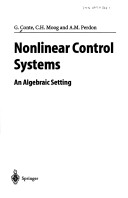Lecture Notes in Control and Information Sciences
1 total work
Vol 242
The approach presented here is based on the use of algebraic methods which are intrinsically linear, rather than differential geometric methods. This allows the exposition to remain simple from a mathematical point of view, and accessible for those with an understanding of linear control theory. It is divided into three parts: Part 1 is devoted to mathematical preliminaries and to the development of tools and methods for system analysis. Part 2 is concerned with solving specific control problems, including disturbance decoupling, non-interactive control, model matching and feedback linearization problems. Part 3 introduces differential algebraic notions and discusses their applications to nonlinear control and system theory. There are examples to illustrate theoretical results.
